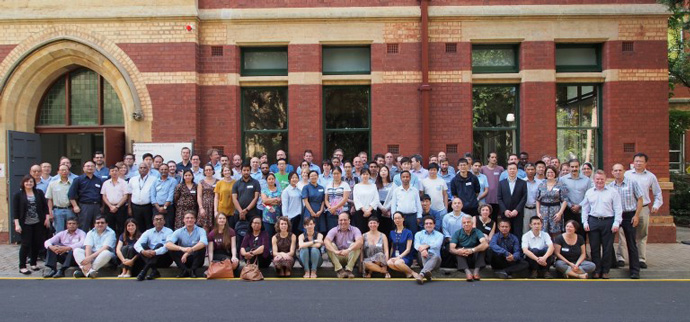

Flooding in Texas in the wake of Hurricane Harvey. (Photo: RoschetzkyIstockPhoto/Thinkstock)
ECMWF scientists joined over 100 participants for an international workshop on hydrometeorological ensemble forecasting from 6 to 9 February 2018. Hosted by the University of Melbourne, the 2018 HEPEX workshop was themed ‘breaking the barriers’ to highlight the challenges facing researchers and practitioners and how they can be overcome.
The workshop presented the latest research into and uses of operational ensemble predictions for floods, droughts, water resource management and hydropower applications.
Topics included data assimilation for ensemble prediction, sub-seasonal to seasonal forecasting and verification of regional- to global-scale forecasting systems.
The Hydrological Ensemble Prediction Experiment (HEPEX) was initiated in 2004 to bridge the gap between meteorologists, hydrologists, forecasters and water managers. The idea was to develop research into and promote the operational use of hydrometeorological ensemble forecasting.
Today HEPEX is an international platform for enthusiastic and devoted scientists, forecasting groups, and end users to find novel solutions to challenges in hydrometeorological ensemble forecasting.
ECMWF was one of founding organisations and has had a leading role in HEPEX from the outset, co-chairing the network between 2004 and 2007 and from 2011 to today. ECMWF's Fredrik Wetterhall is currently a co-chair.

The workshop was attended by more than 100 registered participants from all over the world and included a mixture of keynote talks, oral presentations, posters and discussions. (Photo: Maria-Helena Ramos)
A significant achievement since the birth of HEPEX is that ensemble hydrological forecasts are now produced operationally at national and global scales by several institutions around the world, such as the European and Global Flood Awareness Systems (EFAS and GloFAS) operated by ECMWF.
Ensemble hydrological forecasts for decision-making
Today, the gap between the production of operational ensemble hydrological forecasts and their use for decision-making is narrowing.
An example of this was given by Dasarah Jayasuriya, general manager of public safety at the Australian Bureau of Meteorology (BOM).
He spoke about how users are increasingly using ensemble forecasts for risk-based decisions, rather than relying on deterministic information. This ties in with the emphasis on ensemble forecasting in ECMWF’s Strategy and with the delivery of ensemble forecasts by EFAS/GloFAS.
Another illustration was given by Matthew Bethune, director of the water resources group of the Murray-Darling Basin Authority (MDBA).
He highlighted how operational forecasts are being used for real-world decisions in the water sector, stressing the importance of hydrological forecast products issued for multiple lead times (e.g. from days to months), as they are all essential to help with different water management challenges.
Challenges for hydrological ensemble forecasting
Despite the progress made, some challenges remain. In her keynote address, Prof. Hannah Cloke from the University of Reading, UK, called on scientists to actively engage and communicate better with practitioners. End users should be at the heart of any improvements of a forecasting service, whether focusing on new products, implementing different ensemble forecast verification methods, devising ways of communicating forecast skill and uncertainty, or demonstrating the value of our forecast products.
Another key challenge facing the community that was recurrent in most discussions and talks is access to real-time, good-quality hydrological data to conduct hydrological model calibration, data assimilation, and forecast post-processing.

Participants visited the Australian Bureau of Meteorology in Melbourne. (Photo: Shaun Harrigan)
Christel Prudhomme, Environmental Forecasts Team Leader at ECMWF, summed up the atmosphere at the workshop: “What is clear from the enthusiasm and ambition in Melbourne is that such challenges will not pose a barrier to further progress but will help the community to move forward. HEPEX is making a difference in research as well as in policy and decision-making. The ethos of HEPEX was aptly summarised by Hannah Cloke: Be brave and try new things!”
Conference attendees were also invited to the Melbourne office of the Australian Bureau of Meteorology. The visit included an overview of the operational activities of the Bureau and short presentations from national hazard and hydrological operational forecasting teams.
The workshop was co-organised by the Australian Bureau of Meteorology, the University of Melbourne, CSIRO and the HEPEX co-chairs, with guidance from a multi-institution planning committee.
More information and the workshop programme can be found on the HEPEX website.

The workshop was hosted by the University of Melbourne. (Photo: HEPEX)
In May 2018, ECMWF is hosting a workshop on hydrological services for business. Businesses will have the opportunity to meet the Global Flood Awareness System (GloFAS) development team and influence the future shape of its hydrological services and forecasting products.
